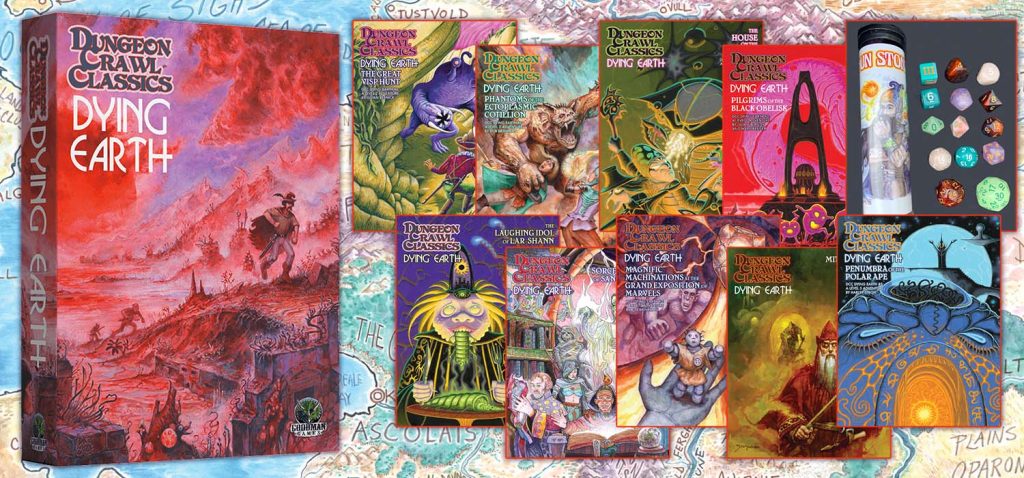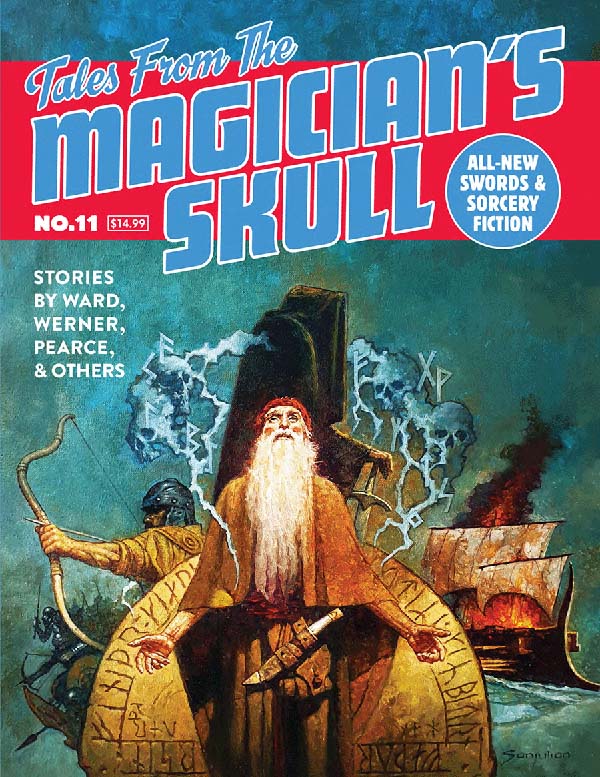
We’re celebrating the release of DCC Dying Earth all this Month with articles in honor of Jack Vance.
A Look at Jack Vance’s The Dragon Masters
by Fletcher Vredenburgh
My father has a great love of Jack Vance which I suspect was for his satirical and sarcastic tone as much as the plots. The treasure trove of sci-fi books stored in our attic included many, many of his works. One it lacked, though, was the novella, The Dragon Masters (1962/1963). I had been inspired to find the book because of the descriptions of assorted “Vance dragons” in Chaosium’s first All the Worlds’ Monsters(1977) supplement. With names like the termagant, blue horror, and long-horned murderer, I was intrigued.
The Dragon Masters first appeared in 1962 in the August issue of the Fred Pohl-edited Galaxy magazine. In 1963, it was published as an Ace Double with another Vance story, The Five Gold Bands. Beating out Ted Sturgeon and Fritz Leiber, among others, it won the Hugo Award for best short story.
Thanks to Gary Gygax’s adoption of Vancian magic as portrayed in The Dying Earth series, I suspect Jack Vance is best known these days for his fantasy. At best, his picaresque stories, like the Big Planet and Planet of Adventure novels. He was also a writer of very good straight up science fiction and it’s as deserving to be read today as anything else from his catalogue. In a mere 102 pages in its first standalone version, The Dragon Masters introduces a wild high concept, provides a synopsis of hundreds of years worth of history, and tells a fast-paced story that culminates in a terrible battle.
Aerlith is a barren planet where humans live in fertile valleys at a gunpowder level of civilization. For centuries they have come under a total of six attacks from space. The reptilian grephs and their army of human troops have come on raids to kill and capture as many humans as they can. In this they are aided by human soldiers they have bred to different tasks; among them, muscular troopers, long nosed trackers, and spindly-limbed riding mounts. During their raids, the grephs bombard and destroy whatever they don’t capture, ensuring the humans remain technologically backwards. From what little information the humans of Aerlith have been able to piece together, they believe they are probably the sole remaining free humans in existence.
During the last greph raid on Aerlith, Kergan Banbeck, leader of Banbeck Vale, managed to capture twenty-three grephs. Over the ensuing years, Banbeck carried out the same sort of breeding regimen the grephs did, creating a wide array of “dragons” from the captured aliens, now called Basics. By the time of The Dragon Masters’ start, there exists a wide array of the creatures.
“Another shelf displayed models of the Banbeck dragons: the rust-red Termagant; the Long-horned Murderer and its cousin the Striding Murderer; the Blue Horror; the Fiend, low to the ground, immensely strong, tail tipped with a steel barbell; the ponderous Jugger, skull-cap polished and white as an egg. A little apart stood the progenitor of the entire group – a pearl-pallid creature upright on two legs, with two versatile central members, a pair of multi-articulated brachs at the neck.“
Joaz Banbeck, descendant of Kergan, is a model of the ultra-competent and rational heroes endemic to the age of John W. Campbell. While not indifferent to the dangers posed by the bellicose Ervis Carcolos of Happy Valley, Joaz is more concerned about the potential return of the grephs. From studying a “celestial armamentarium” he has determined an attack is imminent. Unlike the usual fighting between Banbeck Vale and Happy Valley, the grephs represent an existential threat, so much so, that Joaz suggests a temporary alliance between the two settlements. He also encourages Carcolos to dig deeper tunnels for his people to find sanctuary within during the inevitable raid.
Rebuffed by Carcolos, Joaz attempts to find allies in the Sacerdotes, an ascetic sect that live underground. Their arrival on Aerlith long predates the aboveground humans. They walk about naked, save for waist-length hair and a torc. They see themselves as above the bulk of humanity and are striving for some unknown goal. They too reject Joaz’s proposed alliance, but from his efforts, he learns something of the Sacerdotes’ plans.
When the grephs arrive Vance describes the invasion in terrifying detail. For the grephs, the humans of Aerlith are no more than a resource to be exploited:
“A series of instruments and the eyes of the Basics appraised each man, woman and child, classified them by some system not instantly obvious, whereupon the captives were either hustled up the ramp into the ship or prodded into a nearby booth. Peculiarly, no matter how many persons entered, the booth never seemed to fill.“
The battle is a brutal affair, human-bred dragons against greph-bred humans. For every sub-species one side has, the other has a corresponding one. The grephs’ humans have energy weapons and the humans’ dragons have claws and teeth.
“The Basics prudently halted before the Banbeck Jambles while the Trackers ran ahead like dogs, clambering over the first boulders, rearing high to test the air for odor, peering, listening, pointing, twittering doubtfully to each other. The Heavy Troopers moved in carefully, and their near presence spurred on the Trackers. Abandoning caution they bounded into the heart of the Jambles, emitting squeals of horrified consternation when a dozen Blue Horrors dropped among them. They clawed out heat-guns, in their excitement burning friend and foe alike. With silken ferocity the Blue Horrors ripped them apart.“
Jack Vance is most well-known for his elaborate phrasing and use of rare and archaic words. The above excerpt should indicate he was a master of sharply phrased kinetic action writing as well.
I absolutely love The Dragon Masters as much now as I did when I last read it. I was, in fact, surprised how much more detail and complexity there is in such a short work. . It is a fantastic introduction to the science fiction of Jack Vance, well, really, to Jack Vance in general. Vance was not only one of the great writers of fantasy and science fiction, he was also one of the great American writers.










